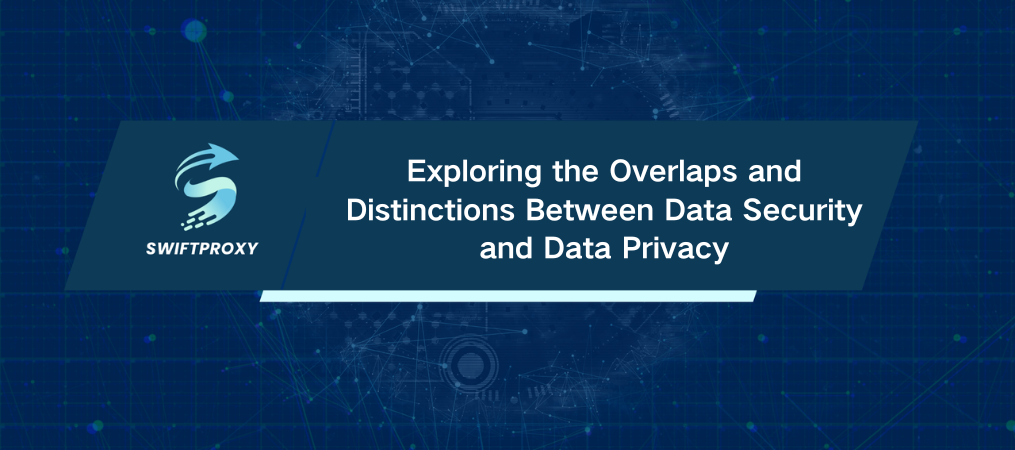Exploring the Overlaps and Distinctions Between Data Security and Data Privacy

In today's digital era, data security and data privacy are pivotal topics in discussions about data management and protection. Although these concepts are closely related, they each fulfill unique roles within the broader framework of data protection.
In this article, we will delve into the details of how data privacy and data security intersect and complement each other.
Data Protection: Shared Goals and Distinct Approaches
The foundation of both data security and data privacy is a shared commitment to safeguarding data. Data security involves establishing digital defenses like firewalls, encryption, and two-factor authentication to block unauthorized access. Meanwhile, data privacy is concerned with the ethical and legal management of data, ensuring compliance with guidelines and regulations related to data handling.
Data security and data privacy differ in their roles within the overall process of data protection. Data security acts as the means to achieve data privacy by creating secure digital defenses to prevent breaches and unauthorized access. Once these defenses are in place, data privacy becomes the end goal. It dictates which data should be protected, how it should be managed, and ensures compliance with legal and ethical standards.
Many organizations implement a zero trust security strategy to enhance data protection by continuously verifying and authenticating users and devices, even after access has been granted. This approach supports the primary goal of safeguarding data privacy.
Compliance and Response: Overlapping Legal Standards and Distinct Breach Management
A major commonality between data privacy and data security is their adherence to legal standards and frameworks. This includes regulations like the General Data Protection Regulation (GDPR) and the California Consumer Privacy Act (CCPA), as well as frameworks such as the NIST Cybersecurity Framework. These guidelines require robust data security measures and offer detailed instructions for proper data management.
The NIST Cybersecurity Framework has become a benchmark in the industry, providing fundamental principles for protecting the confidentiality, integrity, and availability of data. This alignment with legal standards underscores the shared commitment of data privacy and data security to adhering to regulations and ensuring effective data protection and privacy.
Data security and data privacy have distinct roles in managing data breaches. For example, as businesses move from traditional phone systems to cloud PBX software, they may face new security and privacy challenges.
Data security takes a proactive approach, implementing measures to prevent breaches before they happen. This includes securing communication channels and protecting the data being transmitted.
Conversely, data privacy usually takes a reactive approach after a breach occurs. It outlines the necessary steps to address the breach's impact, which may involve notifying affected individuals and relevant regulatory bodies.
Risk Management and Focus: Overlapping Strategies and Distinct Priorities
Risk management is a critical concern for both data security and data privacy. In data security, risk assessments are crucial for identifying, evaluating, and prioritizing cybersecurity threats and vulnerabilities. On the other hand, data privacy relies on well-defined policies to protect your rights as a data subject and prevent violations. By combining risk assessments with robust data privacy policies, organizations create a strong framework for managing data-related risks.
While data security primarily addresses external threats, data privacy also focuses on internal factors. It carefully monitors internal processes within an organization to ensure that privacy rights are consistently upheld.
This may involve verifying that access controls are correctly implemented, ensuring employees receive adequate training in data handling, and swiftly identifying and resolving any potential privacy issues.
Education and Ownership: Shared Learning and Divergent Attitudes
Both data security and data privacy highlight the need for ongoing education. For example, if you choose to register a domain for your website, it's essential to understand how to manage this domain securely and protect the data you gather. As the digital landscape evolves, new risks emerge and existing ones change.
This requires continuous education on the latest best practices, technological advancements, and regulatory updates, including the implications of different domain registrations. By encouraging a culture of learning, organizations can stay at the forefront of data protection and privacy.
Data security focuses on protecting data from unauthorized access and breaches, without directly addressing ownership concerns. In contrast, data privacy emphasizes individual consent and control over personal data, reflecting different attitudes towards data ownership.
While data security is concerned with safeguarding data regardless of its ownership, data privacy emphasizes that ownership and control should belong to the individuals to whom the data pertains.
Collaboration and Protection: Shared Efforts and Focus Areas
Although data security and data privacy have distinct functions, they both require an interdisciplinary and collaborative approach. Neither can succeed in isolation. IT, legal, and compliance departments must work together to ensure that data security measures are in compliance with privacy regulations.
Likewise, privacy officers and legal teams must be well-versed in the capabilities and limitations of security technologies to design effective privacy controls.
Data security ensures that all types of data are protected from unauthorized access. In contrast, data privacy specifically aims to protect sensitive personally identifiable information (PII), such as social security numbers and credit card details.
Web scraping, which involves extracting data without proper consent or compliance, increasingly jeopardizes data privacy by unlawfully collecting sensitive information. To maintain a secure digital environment and protect both data security and privacy, implementing robust data protection measures is essential.
Final Thoughts
A nuanced understanding of the intersections and distinctions between data security and data privacy facilitates more effective navigation of the digital realm. This knowledge enables both individuals and organizations to find the right balance between data protection and privacy standards.
As we generate and engage with ever-growing volumes of data, this understanding becomes increasingly vital for establishing a safer, more secure, and accountable digital environment. To learn more, follow Swiftproxy.

















































